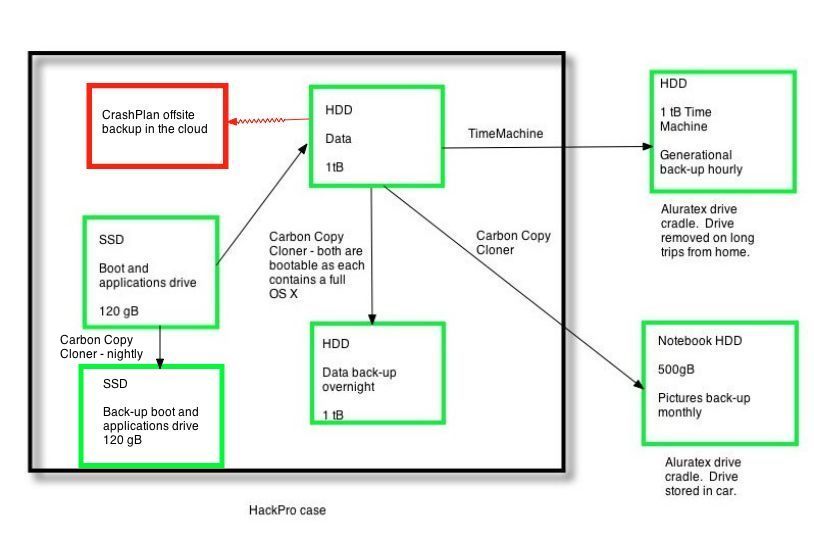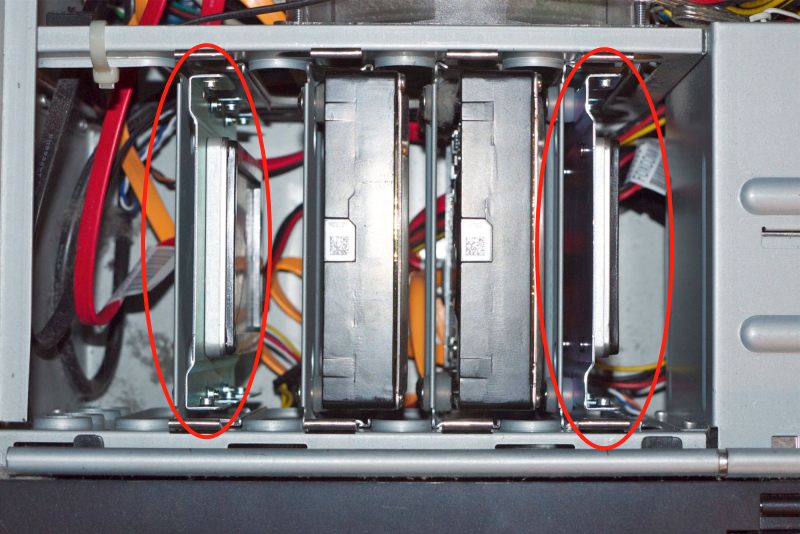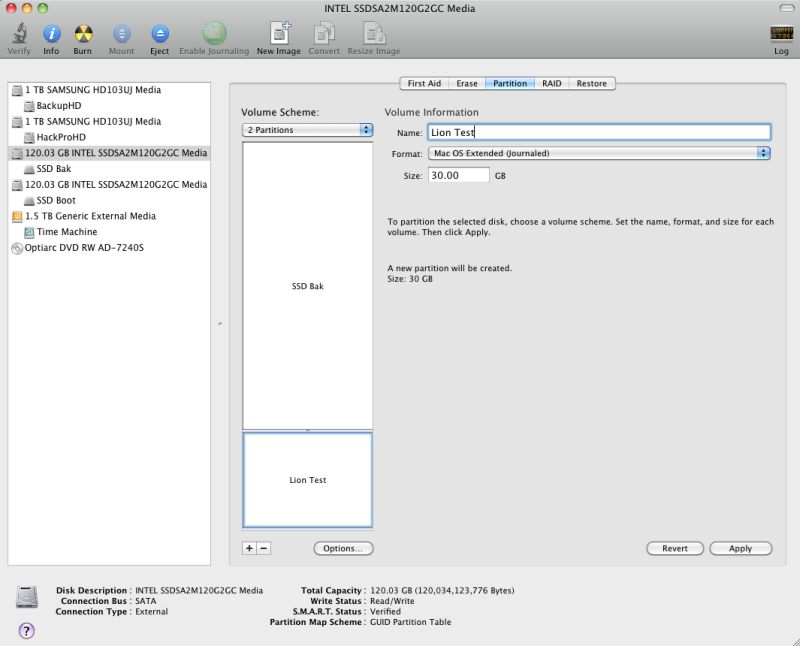Gearing up for Lion.
As OS X Lion will likely involve the usual amount of experimentation to get it working properly on the HackPro, I have added a fourth drive to the computer and its second SSD, so it now contains two SSDs and two HDDs.
The SSDs act as OS and application drives (boot and back-up) whereas the HDDs contain data and back-up data. They also contain OS Snow Leopard as EyeOne Match, the profiling utility for my EyeOne colorimeter, will not work with Lion.
In addition to having an SSD for experimenting with Lion, I also gain a super-fast back-up boot drive. On monthly testing of the HDDs as boot drives I have been increasingly struck by just how slow these are when booted from. After four trouble free months with my first Intel SSD it made sense to add a second. For the test phase I will partition it into two partitions, using Disk Utility; one will contain a straight clone of the existing SSD boot and application drive, and Lion, once released, will reside on the other until fully debugged. Thereafter both will be converted to Lion and Snow Leopard will remain on the HDDs for use with EyeOne Match.
The second SSD will continue to act as a low risk testbed for any new software changes or upgrades.
This is how things will look:

Drive topology after adding the second SSD to HackPro.
I strongly recommend you add an SSD to your work computer. Once you have experienced the speed there is no going back. I paid $230 for each Intel X25-M 120gB SSD.

The HackPro with two SSDs installed.
The incremental heat output and current draw of the second SSD are so low that no additional cooling precautions need be taken in the exceptionally well ventilated Antec Sonata III case with its generously spec’d 500 watt power supply. Installation, which means attaching the SSD to the provided mounting plate and the plate to the Antec’s slide in carrier, plus the connection of power and data cables took FU Steve all of twenty minutes. Carbon Copy Cloner took 27 minutes to clone the existing SSD Boot drive to the new backup SSD, and it needed but two more minutes to verify that the backup was bootable and to add the backup job (Boot->SSD Bak) to Carbon Copy Cloner’s list of automated, nightly backups. You really don’t want to forget that last step!
Partitioning:
As the new backup SSD will also be used as a test bed for OS Lion, to be released next month, I first partitioned it into 90gB and 30gB partitions, using Disk Utility. The latter partition, named ‘Lion Test’, at 30gB, will be more than large enough for OS and selected application testing.

Partitioning the SSD Bak drive to make space for OS Lion.
TRIM:
TRIM is the software code which helps manage garbage on an SSD drive. Apple’s just enabled it in OS Snow Leopard 10.6.8 (the last release before Lion) and it will be included in Lion. At this time the OS will only permit TRIM to be used on Apple installed SSDs. Let’s hope that changes, as many Mac users will be replacing the HDD in their MacBook Pro with an aftermarket SSD to avail themselves of the enhanced speed and lower power consumption. Even if Apple does not step up to the plate here, hacks already exist to make TRIM in Lion work with non-Apple installed SSDs.
Meanwhile, is there anything useful to be divined by comparing the space on the 3 month old SSD in my HackPro with the newly installed backup SSD?
Here’s are the drives inside HackPro as reported on the Desktop:

HackPro drives before partitioning SSD Bak.
In the case of the SSD drive pair, the base drive reports a little more space than the backup one, but not enough to make any difference. Both the backup drives, which include a full Snow Leopard OS, are bootable. So after three months of intense use of the first SSD (top of the above screen snap) there seems to be negligible difference in available space, suggesting that the absence of TRIM has made no material difference. However, be assured I will be looking into adding TRIM support once Lion is installed and will be explaining how to do that in these pages.
Update June 2012: For data on the newer, faster SATA 3 6gd/s SSDs, click
Thomas – great information and just what I’m looking for. As a serious but amateur photographer I am wondering whether I can work with on-board graphics chips satisfactorily, or whether it is necessary to have a separate GPU board (not that they cost a lot). I run PS5 and Lightroom + DxO most the time. Do you have any recommendation on that? Also is it worth going over 8GB RAM if I’m not doing video stuff (although I might in the future). Any comments from you or FU Steve would be appreciated. Nice photos on your website too.
Regards
Colin
Author’s comment:
Hi, Colin.
Thanks for your kind words.
That’s a very timely question on integrated GPUs.
Until recently I would have said go with a separate board. However, the new IvyBridge Intel i5 and i7 CPUs which will be out in new MacBooks any day now, change that. based on my reading of Anandtech (a very reputable site with great CPU insights and knowledge) the GPU in IvyBridge is more than any still photographer needs. As usual, I would junk the stock fan and go with an aftermarket one – the Coolermaster 212 I use in my machines is but $30 or so.
Wait a while for the Hackintosh boards to explain how to enable the integrated GPU in a Hack. It usually takes a little while. The IvyBridge is just hitting the market here and I would go with the i5 ($50 less), and overclock it if you want i7 speeds. Another reason to get a better cooler. I have been running my SandyBridge (immediate predecessor to Ivy) 7/24 overclocked from 3.3 to 4gHz and it’s perfect. If you contemplate overclocking, be sure to het the ‘K’ version of the CPU – that means i5 3570K for the latest IvyBridge.
Price wise it’s a push. A Sandybridge and a decent GPU will run you $215 + $60. An IvyBridge will run you $250. the Ivy’s GPU is much improved over the3 one in the Sandybridge.
As for memory, don’t chintz. It;s so insanely cheap that 16gB makes sense for PS and LR. I notice a welcome speed increase going from 8 to 16. Will 8 suffice? yes. But the extra 8gB for, what, $50, is something you will appreciate. And don’t get 1333 RAM, go for 1600. That’s an instant 20% speed gain for pennies.
Thomas